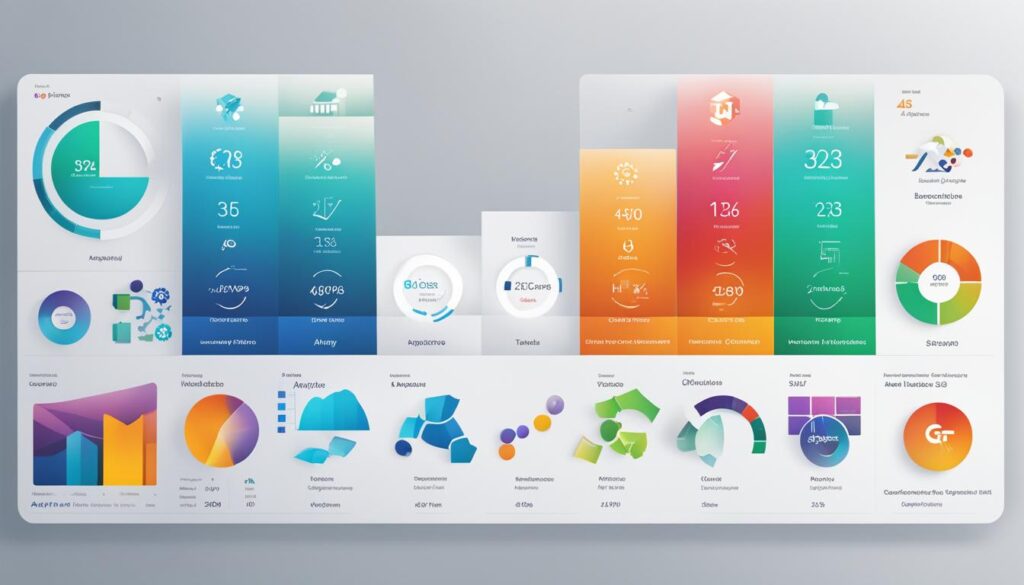In today’s data-driven world, organizations need effective tools and techniques to analyze their business data. With the help of data analysis software, statistical analysis tools, data visualization tools, data mining techniques, predictive analytics tools, business intelligence tools, and data management software, businesses can extract valuable insights and make informed decisions.
Table of Contents
ToggleKey Takeaways:
- Data analysis software, statistical analysis tools, data visualization tools, data mining techniques, predictive analytics tools, business intelligence tools, and data management software are essential for analyzing business data.
- Effective data analysis tools allow organizations to extract valuable insights and make informed decisions.
- Business analytics tools capture and analyze both quantitative and qualitative data from various business systems.
- Regression analysis is a statistical technique used to estimate the relationship between variables and predict future outcomes.
- Monte Carlo simulation is a computational technique used to model possible outcomes and assess risks.
Understanding Business Analytics Tools
Business analytics tools are essential for extracting valuable insights from both quantitative and qualitative data collected from various business systems. These tools enable business analysts to conduct statistical analysis, predictive modeling, and data mining to drive data-driven decision-making and enhance overall productivity and profitability.
Quantitative data refers to numerical data that can be measured and analyzed using statistical methods. It includes information such as sales figures, customer demographics, and website traffic data. Business analytics tools allow analysts to analyze quantitative data and uncover patterns, trends, and correlations that can provide insights into customer behavior, market trends, and operational performance.
On the other hand, qualitative data pertains to non-numerical data that is subjective in nature. This type of data includes information from customer feedback, social media posts, and open-ended survey responses. Business analytics tools assist in analyzing qualitative data through sentiment analysis, text mining, and other techniques to gain insights into customer opinions, preferences, and sentiment towards products or services.
Through business analytics tools, organizations can perform statistical analysis to identify patterns, relationships, and trends in data. Statistical analysis techniques, such as regression analysis and hypothesis testing, can provide valuable insights into various business aspects, including sales forecasting, customer segmentation, and marketing campaign effectiveness.
Predictive modeling is another crucial capability of business analytics tools. By utilizing historical data and statistical algorithms, predictive modeling enables organizations to forecast future outcomes and make data-driven predictions. This empowers businesses to optimize their operations, anticipate customer needs, and make informed decisions that drive success.
Data mining is a vital process within business analytics that involves discovering patterns and extracting meaningful insights from large datasets. Business analytics tools provide advanced data mining algorithms and techniques that enable organizations to uncover hidden patterns, identify anomalies, and make data-driven decisions based on valuable insights.
Business analytics tools play a crucial role in transforming raw data into actionable insights. They provide businesses with the ability to understand their data, discover valuable patterns, and make informed decisions that drive success. The image below visually represents the process of using business analytics tools for data analysis.
Through the utilization of business analytics tools, organizations can harness the power of data analysis to gain a comprehensive understanding of their business operations, customers, and markets. By leveraging quantitative and qualitative data, conducting statistical analysis, predictive modeling, and data mining, businesses can make data-driven decisions that lead to improved efficiency, increased profitability, and a competitive edge in today’s dynamic market environment.
Popular Business Analytics Tools
When it comes to business analytics, there is a wide array of tools available in the market, each offering unique features and functionalities. These tools play a crucial role in helping organizations analyze their data effectively and make informed decisions. Let’s take a closer look at some of the most popular business analytics tools:
- SAS Business Analytics: SAS Business Analytics provides a comprehensive suite of analytics solutions, covering areas such as data management, business intelligence, and predictive analytics. With its advanced capabilities, SAS is widely used by enterprises across various industries.
- QlikView: QlikView is a powerful data visualization and business intelligence tool. It enables users to explore data intuitively through interactive charts, graphs, and dashboards. QlikView’s associative data model allows for seamless data integration and analysis.
- Board: Board is a unified business intelligence and performance management platform. It offers a range of functionalities, including reporting, planning, and predictive analytics. Board’s user-friendly interface makes it easy to access and analyze data from multiple sources.
- Splunk: Splunk specializes in machine data analysis, providing valuable insights into system performance, security, and operational efficiency. It is widely used for log analysis, event monitoring, and threat detection in IT environments.
- Sisense: Sisense is a leading business intelligence platform that enables users to combine and analyze large datasets effortlessly. Its innovative technology allows for fast and efficient data processing, empowering organizations to uncover hidden insights.
Data Analysis Tools Comparison
| Name | Key Features | Industries |
|---|---|---|
| SAS Business Analytics | Advanced analytics, data management, business intelligence | Various industries |
| QlikView | Data visualization, business intelligence, data integration | Finance, healthcare, retail |
| Board | Reporting, planning, predictive analytics | Manufacturing, finance, retail |
| Splunk | Machine data analysis, log management, threat detection | IT, cybersecurity |
| Sisense | Big data analytics, data blending, dashboarding | Marketing, e-commerce, healthcare |
These are just a few examples of the popular business analytics tools available today. Other notable tools include Microstrategy, KNIME, Dundas BI, TIBCO Spotfire, Tableau Big Data Analytics, Excel, Power BI, Domo, and RapidMiner. Each of these tools offers unique functionalities and caters to specific business needs.
By leveraging these business analytics tools, companies can gain valuable insights, streamline processes, and make data-driven decisions that drive success in today’s competitive landscape.

Regression Analysis for Quantitative Data
Regression analysis is a powerful statistical technique used to estimate the relationship between a dependent variable and one or more independent variables. It plays a crucial role in business data analysis, allowing organizations to identify correlations and make predictions about future outcomes.
When conducting regression analysis, the dependent variable is the one being predicted or explained, while the independent variables are the factors that may influence or affect the dependent variable. By analyzing quantitative data through regression analysis, businesses can gain valuable insights into the factors that impact their dependent variable and make informed decisions based on these relationships.
Predictive modeling is a key application of regression analysis, enabling businesses to forecast future outcomes, trends, and patterns. By analyzing historical data and identifying significant independent variables, businesses can develop models that can be used to predict and anticipate future scenarios.
Example of Regression Analysis:
Let’s consider a retail company that wants to analyze the relationship between its advertising expenditure and sales revenue. The dependent variable in this case is the sales revenue, while the independent variable is the advertising expenditure. By performing regression analysis on historical data, the company can determine how changes in advertising expenditure affect sales revenue.
“Regression analysis allows businesses to measure the impact of independent variables on the dependent variable and enables accurate predictions for future outcomes. By understanding the relationship between variables, organizations can optimize their strategies and make data-driven decisions.”
Here’s a simplified table that demonstrates a regression analysis of the advertising expenditure and sales revenue for the retail company:
| Advertising Expenditure (in dollars) | Sales Revenue (in dollars) |
|---|---|
| 1000 | 5000 |
| 2000 | 6000 |
| 3000 | 7000 |
| 4000 | 8000 |
This table represents a simplified dataset where the advertising expenditure increases in increments of $1000, and the corresponding sales revenue is recorded. By performing regression analysis on this dataset, the retail company can determine the relationship between advertising expenditure and sales revenue, enabling more informed decision-making when creating their advertising strategies.
Regression analysis is just one of the many statistical techniques available for data analysis in business. By utilizing these techniques, organizations can uncover valuable insights, make data-driven decisions, and drive success in today’s competitive landscape.

Monte Carlo Simulation
Monte Carlo simulation is a powerful computational technique used to analyze and model a range of possible outcomes and their associated probability distributions. It is widely employed in various fields, including finance, engineering, and project management, to assess risk and uncertainty.
By simulating different scenarios and their likelihoods, businesses can gain insights into the potential risks and rewards associated with their decisions. Monte Carlo simulation can help organizations make informed choices and optimize their strategies by quantifying the impact of various variables and uncertainties.
This technique is particularly valuable for conducting risk analysis. By generating a large number of random samples based on probability distributions, Monte Carlo simulation can provide a comprehensive understanding of the potential outcomes and their probabilities. It enables businesses to identify potential risks, evaluate their impact, and develop effective risk mitigation strategies.
Probability distributions play a crucial role in Monte Carlo simulation. By incorporating probability distributions into the simulation model, businesses can account for the inherent uncertainty and variability in their data. Commonly used probability distributions include normal distribution, uniform distribution, and triangular distribution.
“Monte Carlo simulation is a valuable tool for decision-making under uncertainty. By simulating a large number of potential outcomes, businesses can assess the probability of different scenarios and make informed choices based on the expected values and risks associated with each outcome.”
In summary, Monte Carlo simulation is an essential technique for risk analysis and decision-making. By modeling a range of possible outcomes and their probability distributions, businesses can gain insights into the potential risks and rewards, enabling them to make informed choices and optimize their strategies.
Example:

Consider a real estate developer who wants to assess the profitability of a new housing project. The developer can use Monte Carlo simulation to simulate various factors such as construction costs, sale prices, and market conditions. By running thousands of iterations, the simulation can provide a distribution of potential profits, allowing the developer to make informed decisions about the project’s feasibility and identify potential risks.
Other Quantitative Data Analysis Techniques
In addition to regression analysis and Monte Carlo simulation, there are several other quantitative data analysis techniques that businesses can utilize to gain valuable insights. Let’s explore these techniques:
Factor Analysis
Factor analysis is a statistical method used to identify underlying factors that contribute to a set of observed variables. It helps businesses understand the relationships among different variables and identify the key factors driving certain outcomes. By analyzing the interdependencies between variables, factor analysis provides valuable insights into complex datasets.
Cohort Analysis
Cohort analysis involves analyzing groups of individuals who share a common characteristic or experience within a specific time period. It helps businesses understand the behavior and preferences of different cohorts over time and enables targeted marketing campaigns and personalized offerings. By studying cohorts, businesses can gain insights into customer retention, product adoption, and long-term trends.
Cluster Analysis
Cluster analysis is a technique used to group similar data points together based on their similarities. By identifying patterns and relationships in the data, businesses can segment their customers, products, or markets into distinct groups. Cluster analysis helps businesses understand the characteristics and behaviors of different segments, allowing them to tailor their strategies and offerings accordingly.
Time Series Analysis
Time series analysis involves analyzing data collected at regular intervals over time to identify patterns, trends, and seasonality. It helps businesses understand how variables change over time and make informed predictions. Time series analysis is widely used in finance, economics, sales forecasting, and many other fields to analyze historical data and make future projections.
By utilizing these quantitative data analysis techniques, businesses can unlock valuable insights hidden within their datasets and make data-driven decisions. The image below illustrates the importance of these techniques in driving business success.
Now that we’ve explored the different quantitative data analysis techniques, let’s move on to the next section to learn about sentiment analysis for qualitative data.
Sentiment Analysis for Qualitative Data
Sentiment analysis is a crucial technique for analyzing qualitative data, especially unstructured text data, to gain a deeper understanding of the sentiment or opinion expressed. It plays a significant role in various areas, including social media monitoring, customer feedback analysis, and product reviews.
Using sentiment analysis, businesses can extract valuable insights from unstructured data and accurately gauge customer opinions and preferences. By analyzing the sentiment behind customer feedback or social media mentions, companies can identify potential issues or areas for improvement and make data-driven decisions to enhance their products and services.
One of the main challenges in sentiment analysis is dealing with unstructured text data. Unlike structured data, which is organized and categorized, unstructured data lacks a predefined format or structure, making it difficult to analyze using traditional data analysis techniques.

To overcome this challenge, text analysis techniques are utilized in sentiment analysis. These techniques involve natural language processing (NLP) algorithms that analyze and decipher textual data to determine the sentiment behind it. NLP algorithms can identify and classify words, phrases, and contextual clues to determine whether the sentiment expressed is positive, negative, or neutral.
“Sentiment analysis allows us to tap into the unstructured data and gain insights into what customers truly think and feel. By understanding their sentiments, we can tailor our products and services to meet their needs and expectations more effectively.”
Sentiment analysis provides businesses with actionable insights that can drive decision-making and strategy development. By monitoring sentiment trends over time, companies can gauge the effectiveness of their marketing campaigns, customer satisfaction levels, and overall brand perception.
Benefits of Sentiment Analysis for Businesses
Implementing sentiment analysis can offer several advantages for businesses:
- Accurate understanding of customer sentiment: Sentiment analysis enables businesses to accurately gauge customer sentiment by analyzing vast amounts of unstructured data originating from various sources, such as social media, surveys, and customer feedback.
- Identification of emerging trends and patterns: By analyzing sentiment, businesses can identify emerging trends, patterns, and sentiment fluctuations that can impact customer behavior and preferences. This information can be used to proactively adapt strategies and offerings.
- Brand reputation management: Sentiment analysis helps businesses monitor their brand reputation by identifying issues, complaints, or negative sentiment surrounding their products or services in real-time. This enables companies to respond promptly and address customer concerns to maintain a positive brand image.
- Competitive analysis: Sentiment analysis can also be used to analyze the sentiment surrounding competitors’ products or services, providing businesses with valuable insights into the strengths and weaknesses of their competitors, as well as opportunities for differentiation.
Overall, sentiment analysis empowers businesses to extract meaningful insights from unstructured data, gain a comprehensive understanding of customer sentiment, and make data-driven decisions to drive growth and success.
The Data Analysis Process
The data analysis process is crucial for businesses to extract valuable insights from their data and make informed decisions. It involves several key steps, including data collection, data cleaning, data transformation, and data modeling.
Data Collection
Data collection is the first step in the data analysis process. Businesses gather data from various sources, such as customer surveys, website analytics, sales records, and social media platforms. This process involves identifying relevant data sources, extracting the data, and ensuring its accuracy and validity.
Data Cleaning
Data cleaning, also known as data cleansing or data scrubbing, is the process of removing errors, inconsistencies, and duplicates from the collected data. This step is crucial to ensure the data’s quality and reliability. Various techniques, such as removing outliers, handling missing values, and standardizing data formats, are used to clean the data.
Data Transformation
Data transformation involves converting the cleaned data into a usable format for analysis. This step may include aggregating data, creating new variables, or merging datasets to derive meaningful insights. Data transformation is essential to prepare the data for the next step of the analysis process.
Data Modeling
Data modeling is the final step in the data analysis process. It involves applying statistical and mathematical techniques to the transformed data to uncover patterns, relationships, and trends. Data modeling techniques may include regression analysis, clustering, time series analysis, or machine learning algorithms. The goal is to generate actionable insights and make data-driven decisions based on the analysis results.
| Step | Description |
|---|---|
| Data Collection | Gathering data from various sources, such as surveys, analytics, and records. |
| Data Cleaning | Removing errors, inconsistencies, and duplicates from the collected data. |
| Data Transformation | Converting the cleaned data into a usable format for analysis. |
| Data Modeling | Applying statistical and mathematical techniques to uncover patterns and trends. |
The data analysis process is iterative, meaning that it may involve going back and forth between the different steps as new insights or challenges arise. By following this process, businesses can extract valuable information from their data, gain a deeper understanding of their operations, and make data-driven decisions that drive success.
The Best Tools for Data Analysis
When it comes to data analysis, having the right tools can make all the difference. With the ever-increasing amount of data being generated by businesses, it’s crucial to have robust and feature-rich software to extract valuable insights. Here, I will introduce you to some of the best tools available for data analysis.
- Microsoft Power BI: A powerful business intelligence tool that offers interactive data visualization and advanced analytics capabilities.
- SAP BusinessObjects: An enterprise-level solution with comprehensive reporting, ad hoc analysis, and self-service analytics features.
- Sisense: An intuitive platform that enables business users to easily analyze complex data sets and create interactive visualizations.
- TIBCO Spotfire: Combines advanced analytics, data visualization, and collaboration features to drive data-driven decision-making.
- Thoughtspot: A search and AI-driven analytics platform that allows users to analyze data with simple search queries.
- Qlik: Provides interactive dashboards and visualizations for data exploration and discovery.
- SAS Business Intelligence: Offers a wide range of analytics and reporting capabilities for in-depth data analysis.
- Tableau: An industry-leading data visualization tool that empowers users to create interactive dashboards and reports.
- Google Data Studio: A free and collaborative tool for creating dynamic and interactive reports and dashboards.
- Redash: An open-source platform that allows users to connect and query data sources and create visualizations.
- Periscope Data: Provides data visualization and SQL querying capabilities to analyze and explore large datasets.
- Metabase: A user-friendly tool that simplifies data exploration and visualization for non-technical users.
- Jupyter Notebook: An open-source web application that allows users to create and share documents containing live code, equations, visualizations, and narrative text.
- IBM Cognos: A comprehensive suite of business intelligence and performance management tools for data analysis and reporting.
- Chartio: Enables businesses to analyze and visualize their data without requiring extensive coding knowledge.
- Mode: A collaborative analytics platform that combines SQL editing, visualization, and reporting capabilities.
- KNIME: An open-source data analytics platform that allows users to visually create data flows, execute machine learning algorithms, and deploy models.
These tools offer a wide range of functionalities, including data visualization, report generation, and advanced analytics. Selecting the right tool depends on your specific requirements and the complexity of your data analysis tasks. Whether you need interactive dashboards, self-service analytics, or advanced statistical modeling, there’s a tool out there to meet your needs.
Having the best tools for data analysis is crucial in today’s data-driven business landscape. With the right software at your fingertips, you can unlock valuable insights from your data and make informed decisions to drive business success.
Other Popular Data Analysis Tools
In addition to the previously mentioned tools, there are other popular data analysis tools that businesses can consider. Two notable options in this field are Domo and RapidMiner.
Domo is a comprehensive analytics platform that offers a wide range of features to help businesses harness the power of their data. It provides self-service analytics, allowing users to explore and analyze their data without relying on IT or data science teams. With Domo, businesses can seamlessly integrate data from various sources, perform predictive modeling, and visualize insights through intuitive dashboards and reports.
RapidMiner is another powerful tool for data analysis. It offers advanced analytics capabilities, including data integration, predictive modeling, and visualization. RapidMiner’s user-friendly interface makes it easy for businesses to build and deploy predictive models, automate data workflows, and gain valuable insights. It supports a wide range of data formats and provides extensive libraries for machine learning and data mining.
Both Domo and RapidMiner play a crucial role in enabling data-driven decision-making. These tools empower businesses to make informed choices based on a deeper understanding of their data.
Comparison of Domo and RapidMiner
| Features | Domo | RapidMiner |
|---|---|---|
| Self-service analytics | ✓ | |
| Data integration | ✓ | ✓ |
| Predictive modeling | ✓ | ✓ |
| Visualization | ✓ | ✓ |
| Support for machine learning | ✓ | |
| User-friendly interface | ✓ | ✓ |
As shown in the table above, both Domo and RapidMiner have overlapping functionalities, such as data integration, predictive modeling, and visualization. However, RapidMiner also offers support for machine learning, making it a suitable choice for businesses with more advanced analytics needs. On the other hand, Domo excels in providing a user-friendly interface that enables self-service analytics, making it accessible to a broader range of users within an organization.
Overall, the selection between Domo and RapidMiner depends on the specific requirements and preferences of a business. Both tools offer robust capabilities that can drive data-driven decision-making and help businesses uncover valuable insights from their data.
Conclusion
Business data analysis plays a crucial role in enabling informed decision-making and unlocking valuable insights. By utilizing a wide range of tools and techniques, businesses can effectively analyze their data, uncover patterns and trends, and make data-driven decisions. Whether it’s regression analysis, Monte Carlo simulation, sentiment analysis, or other quantitative and qualitative data analysis techniques, these tools empower organizations to gain a competitive edge and achieve their goals.
In today’s data-driven world, businesses have access to a plethora of business data analysis tools. From statistical analysis software to predictive analytics tools, these technologies provide organizations with the means to extract valuable insights from their data. With the help of data visualization tools, businesses can transform complex data into visually appealing dashboards and reports, enabling stakeholders to understand information quickly and make informed decisions.
By leveraging the power of business data analysis, companies can uncover hidden opportunities, identify potential risks, and optimize their operations. These tools and techniques enable organizations to gain a comprehensive understanding of their data, identify key insights, and make informed decisions to drive success. In today’s competitive landscape, businesses that harness the power of analytics are better positioned to stay ahead, make smarter choices, and achieve their objectives.
FAQ
What are business data analysis tools and techniques?
Business data analysis tools and techniques are software applications and methods used to analyze data for businesses. They include data analysis software, statistical analysis tools, data visualization tools, data mining techniques, predictive analytics tools, business intelligence tools, and data management software.
Why are business analytics tools important?
Business analytics tools are important because they enable organizations to capture and analyze both quantitative and qualitative data from various business systems. These tools facilitate statistical analysis, predictive modeling, and data mining to provide key insights that enhance productivity and profitability.
What are some popular business analytics tools?
Some popular business analytics tools include SAS Business Analytics, QlikView, Board, Splunk, Sisense, Microstrategy, KNIME, Dundas BI, TIBCO Spotfire, Tableau Big Data Analytics, Excel, Power BI, Domo, and RapidMiner. These tools offer a wide range of capabilities for data analysis and reporting.
What is regression analysis?
Regression analysis is a statistical technique used to estimate the relationship between a dependent variable and one or more independent variables. It is commonly used in business data analysis to identify correlations and predict future outcomes.
What is Monte Carlo simulation?
Monte Carlo simulation is a computational technique used to model a range of possible outcomes and their probability distributions. It is particularly useful for conducting risk analysis and forecasting future trends.
What are some other quantitative data analysis techniques?
Other quantitative data analysis techniques include factor analysis, cohort analysis, cluster analysis, and time series analysis. These techniques help businesses identify underlying factors, analyze groups of individuals over time, group similar data points together, and examine data patterns and trends.
What is sentiment analysis?
Sentiment analysis is a technique used to analyze qualitative data, particularly unstructured text data, to understand the sentiment or opinion expressed. It is commonly used in social media monitoring, customer feedback analysis, and product reviews.
What is the data analysis process?
The data analysis process involves several steps, including data collection, data cleaning, data transformation, and data modeling. Businesses collect data from various sources, clean and organize it, transform it into a usable format, and model it to uncover meaningful insights.
What are some of the best tools for data analysis?
Some of the best tools for data analysis include Microsoft Power BI, SAP BusinessObjects, Sisense, TIBCO Spotfire, Thoughtspot, Qlik, SAS Business Intelligence, Tableau, Google Data Studio, Redash, Periscope Data, Metabase, Jupyter Notebook, IBM Cognos, Chartio, Mode, and KNIME. These tools offer various functionalities for data visualization, report generation, and advanced analytics.
Are there any other popular data analysis tools?
Yes, Domo and RapidMiner are also popular data analysis tools. They offer comprehensive analytics platforms with features such as self-service analytics, predictive modeling, and visualization.
Why is business data analysis important?
Business data analysis is important because it enables informed decision-making and helps businesses gain valuable insights from their data. By utilizing the right tools and techniques, organizations can effectively analyze their data, uncover patterns and trends, and make data-driven decisions.











